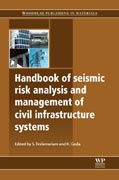
Handbook of Seismic Risk Analysis and Management of Civil Infrastructure Systems
Tesfamariam, S
Goda, K
Earthquakes represent a major risk to buildings, bridges and other civil infrastructure systems, causing catastrophic loss to modern society. Handbook of seismic risk analysis and management of civil infrastructure systems reviews the state of the art in the seismic risk analysis and management of civil infrastructure systems.Part one reviews research in the quantification of uncertainties in ground motion and seismic hazard assessment. Part twi discusses methodologies in seismic risk analysis and management, whilst parts three and four cover the application of seismic risk assessment to buildings, bridges, pipelines and other civil infrastructure systems. Part five also discusses methods for quantifying dependency between different infrastructure systems. The final part of the book considers ways of assessing financial and other losses from earthquake damage as well as setting insurance rates.Handbook of seismic risk analysis and management of civil infrastructure systems is an invaluable guide for professionals requiring understanding of the impact of earthquakes on buildings and lifelines, and the seismic risk assessment and management of buildings, bridges and transportation. It also provides a comprehensive overview of seismic risk analysis for researchers and engineers within these fields. This important handbook reviews the wealth of recent research in the area of seismic hazard analysis in modern earthquake design code provisions and practicesExamines research into the analysis of ground motion and seismic hazard assessment, seismic risk hazard methodologiesAddresses the assessment of seismic risks to buildings, bridges, water supply systems and other aspects of civil infrastructure INDICE: Part 1 Ground motions and seismic hazard assessment: Probabilistic seismic hazard analysis of civil infrastructure; Uncertainties in ground motion prediction in probabilistic seismic hazard analysis (PSHA) of civil infrastructure; Spatial correlation of ground motions in estimating seismic hazards to civil infrastructure; Ground motion selection for seismic risk analysis of civil infrastructure; Assessing and managing risk of earthquake-induced liquefaction to civil infrastructure. Part 2 Seismic risk analysis methodologies: Seismic risk analysis and management of civil infrastructure systems: An overview; Seismic risk analysis using Bayesian belief networks; Structural vulnerability analysis of civil infrastructure facing seismic hazards; Earthquake risk management of civil infrastructure: Integrating soft and hard risks; A capability approach for seismic risk analysis and management; Resilience-based design (RBD) modelling of civil infrastructure to assess seismic hazards. Part 3 Assessing seismic risks to buildings: Assessing seismic risks for new and existing buildings using performance-based earthquake engineering (PBEE) methodology; Assessing the seismic vulnerability of masonry buildings; Vulnerability assessment of reinforced-concrete structures for fire and earthquake risk; Seismic risk models for ageing and deteriorating buildings and civil infrastructure; Stochastic modeling of deterioration in buildings and civil infrastructure. Part 4 Assessing seismic risks to bridges and other components of civil infrastructure networks: Risk assessment and management of civil infrastructure networks: A systems approach; Seismic vulnerability analysis of a complex interconnected civil infrastructure; Seismic reliability of deteriorating reinforced concrete bridges; Using a performance-based earthquake engineering (PBEE) approach to estimate structural performance targets for bridges; Incremental dynamic analysis (IDA) applied to seismic risk assessment of bridges; Effect of soil-structure interaction and spatial variability of ground motion on seismic risk assessment of bridges; Seismic risk management of water pipeline networks; Seismic risk assessment of water supply systems; Seismic risk assessment for oil and gas pipelines; Seismic risk analysis of wind turbine support structures. Part 5 Assessing financial and other losses from earthquake damage: Seismic risk and possible maximum loss (PML) analysis of reinforced concrete structures; Seismic risk management of insurance losses using extreme value theory and copula; Probabilistic assessment of earthquake insurance rates for buildings; Assessing global earthquake risks: The Global Earthquake Model (GEM) initiative; Strategies for rapid global earthquake impact estimation: The Prompt Assessment of Global Earthquakes for Response (PAGER) system.
- ISBN: 978-0-85709-268-7
- Editorial: Woodhead Publishing
- Encuadernacion: Cartoné
- Páginas: 920
- Fecha Publicación: 30/04/2013
- Nº Volúmenes: 1
- Idioma: Inglés
